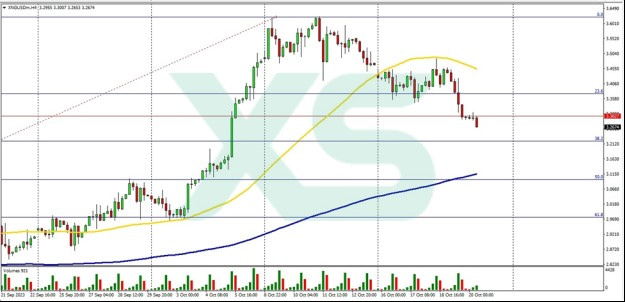Natural Gas Prices Decreased this Week, and currently, natural gas is trading at $3.26 per million British Thermal Units (MMBtu). Gas supplies to Europe remained higher than average despite the closure of gas imports from Israeli occupation through Egypt.
With European gas storage tanks filled up to 85%, it seems that the European Union is prepared to face the early cold temperatures before the arrival of winter. Even with geopolitical tensions threatening to escalate in the Middle East, one of the world’s largest natural gas demand sources, Europe, seems to have the capacity to sustain itself for an extended period.
At the same time, the U.S. Dollar Index (DXY) has been fluctuating with high volatility and instability. Geopolitical tensions in Palestine are supporting the flow of liquidity into safe-haven assets.
On the other hand, yields on U.S. Treasury bonds have risen to their highest levels in years, with 10-year U.S. Treasury bonds surpassing 5% at one point. A fundamental rule in financial markets is that yields above 5% represent a turning point, where high yields on bonds and securities may begin to harm the economy and potentially lead to a recession shortly, weakening the strength of the U.S. dollar.
I believe that the market drivers influencing natural gas prices are the escalating events in the Middle East at present. The latest data from the Egyptian Ports Authority shows that liquefied natural gas (LNG) vessels are departing ports with only partial loads of LNG due to the closure of gas fields in the occupied Palestinian territories.
With the increasing frequency of nightly shelling in Middle Eastern countries and the deployment of drones by a U.S. military carrier, the United States could be drawn into war, which could lead to an increase in gas prices in the near term. According to estimates from the Institute of Energy Economics, Japan (IEEJ), the world will need $7 trillion to ensure an adequate supply of gas until 2050.
Today, the markets are eagerly awaiting some important data in addition to geopolitical news and developments in the Middle East conflict. The Baker Hughes Gas Rig Count report is scheduled to be released this evening at approximately 17:00 GMT.
It’s worth noting that the previous figure was 117, which is still far from the high number of 167 in 2022. No market expectations have been set, and it is believed that this data will significantly impact the markets by the end of the day and the weekly closures of natural gas and other assets.
Technical analysis of the (XNG/USD) prices
Natural gas prices remain elevated, up more than 25% since the start of the conflict in Gaza. With the approach of the winter season, I anticipate increased price volatility.
Gas prices could see a significant decline as temperatures drop and winter officially begins. Prices will also be influenced by heightened risks due to tensions in the Middle East during the winter period. I expect a substantial increase in demand for natural gas and petroleum derivatives, leading to unusual price movements in the markets.
Given the current geopolitical headlines and the technical price action on the daily chart, I anticipate sharp fluctuations in the short and medium term. There are no significant resistance levels in place to prevent further price increases, except for the $3.65 level, which was last seen on January 17. If this level is breached and confirmed, prices are likely to climb towards the 2023 high, near $4.3080.

(XNG/USD) Prices Chart – MT4 Platform from XS.com
From another negative technical perspective, the bearish scenario becomes active if the trend channel fails to act as support near $3.37 and prices remain consistently below it, closing the week lower.
In this case, natural gas prices could briefly decline to around $3.07, which is near the peak support from mid-August. If the decline below this level turns into a primary trend, prices may drop below $3 towards the area near the 55-day simple moving average at approximately 2.98 units.



